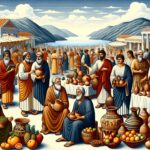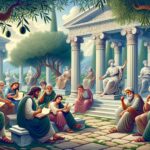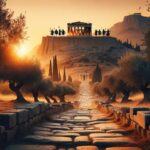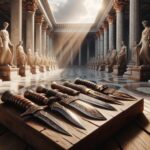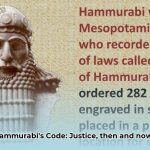We all know about the Library of Alexandria, right? But did you know it was just one star in a whole constellation of amazing ancient libraries? Learn more about ancient Greek engineering marvels here. This article is a deep dive into some of the other incredible – and sadly, lost – libraries from the past. We’ll explore what made them special, what happened to them, and what we can still learn from the bits and pieces that remain. Think mysterious collections, fascinating histories, and the age-old struggle to preserve knowledge – it’s a story full of suspense and discovery!
Lost Libraries of the Ancient World Besides Alexandria: Unveiling Ancient History
We all know the legendary Library of Alexandria, a symbol of ancient learning. But did you know that many other incredible libraries thrived in the ancient world, only to be lost to time and destruction? These libraries weren’t just dusty rooms full of books; they were vibrant centers of intellectual life, each with its own unique story and contribution to human knowledge. Let’s uncover some of these fascinating lost libraries, and what they tell us about the past and the legacy of ancient knowledge.
1. The Library of Pergamon: A Challenger to Alexandria’s Reign and Hellenistic Culture
Picture this: ancient Pergamon, in modern-day Turkey – a city so influential, its library almost matched Alexandria’s in size and reputation during the Hellenistic era (roughly 323-31 BC). Think of scholars from all over the Mediterranean flocking to its halls. But what made Pergamon’s library really stand out? They perfected parchment (writing material made from animal skin)! Before that, papyrus scrolls were the norm. Parchment was more durable and easier to write on – a game changer for storing knowledge. It’s estimated that the Library of Pergamum amassed over 200,000 volumes. According to Plutarch, Mark Anthony took these documents from Pergamum and gifted them to Cleopatra. The scrolls could have been in the Great Library of Alexandria’s collection when it was burned. Sadly, wars and the passage of time took their toll, and much of the library’s collection vanished. Yet, its legacy remains – a clear sign of how seriously the ancient Greeks valued learning and intellectual progress. Their advancement in parchment technology alone shows us their ingenuity. This innovation marks a critical shift in how knowledge was preserved, stored, and disseminated in the ancient world.
2. Ashurbanipal’s Library at Nineveh: A Treasure Trove of Cuneiform Tablets and Mesopotamian History
Now, let’s travel to Nineveh, the mighty capital of the Assyrian Empire (around 7th century BC). King Ashurbanipal’s royal library wasn’t just a random collection of writings. It was a superbly organized archive – a true marvel of ancient record-keeping. We’re talking thousands of clay tablets inscribed with cuneiform script, containing everything from epic poems and legal codes to religious beliefs and scientific observations. Imagine the sheer volume of knowledge stored there! Long considered the first systematically collected library, it was rediscovered in the 19th century. The tablets had also been classified according to a precise system. Though the city was sadly destroyed, and the library along with it, approximately 30,000 of these tablets survived. They’ve given us a priceless window into Assyrian life and the wider world of ancient Mesopotamia. These fragments offer invaluable insights into their culture, language, and beliefs, serving as a cornerstone of our understanding of the Near East, and allowing us to understand law, religion, and science of the period.
3. The Library of Celsus at Ephesus: More Than Just Books and Roman Pride
Fast forward to Ephesus, a bustling Roman city, where the Library of Celsus (built around the 2nd century AD) wasn’t just a building crammed with scrolls. It was a magnificent public structure, a true architectural showstopper reflecting Roman pride in intellect and learning. It was a statement. Gaius Julius Aquila built it in honor of his father, the Roman consul Tiberius Julius Celsus. As such the library acted as both a seat of learning and as a mausoleum. The library’s impressive design speaks volumes about how important knowledge was to the Roman people. Unfortunately, fires and earthquakes eventually claimed it, leaving only a meticulously reconstructed façade as a visual testament to its former splendor. Although the books themselves are long gone, the library’s very existence tells a powerful tale of the Roman commitment to learning, helping us to understand their culture and values. The library housed 12,000 scrolls which were deposited in several cabinets along the wall. Statues and other items saved from the ruins of the library are on show in the Museum of Istanbul.
4. The Roman Imperial Library: The Heart of Roman Thought and Imperial Knowledge?
The Roman Imperial Library is a bit of a mystery. We don’t know its exact location or the full extent of its collection, but evidence suggests it played a crucial role in the intellectual life of the Roman Empire. Unlike some libraries that merely stored texts, this one likely actively copied, translated, and spread knowledge throughout the empire. Emperor Constantius II requested for the rolls of papyrus to be copied onto parchment or vellum in order that they would be preserved. Losing this central hub of Roman learning represents a massive gap in our knowledge of Roman literature and thought. The sheer scale of its potential influence suggests a significant loss for history, hindering our ability to understand them fully. Some assessments place the collection at just over 100,000 volumes which included papyrus scrolls and codices bound in parchment.
5. The Serapeum at Alexandria: A Later Chapter in Alexandria’s Story and Religious Studies
Although we often talk about the Library of Alexandria, there’s another crucial piece of the puzzle: the Serapeum. This was part temple, part library, a complex that existed after the original Library of Alexandria’s decline. It continued to safeguard important texts until the late 4th century AD. While related to the earlier library’s tradition, the Serapeum had its own unique identity, blending intellectual and religious studies. The destruction of the Serapeum, which some associate with a religious conflict, marked a significant turning point in late antiquity, symbolizing a pivotal change in the intellectual atmosphere of the Mediterranean world.
A Closer Look: Lost Libraries Compared and Ancient Knowledge
Let’s summarize what we’ve learned about these lost libraries in a handy table:
| Library Name | Location | Time Period | What it Held | What Happened to It | What Remains |
|---|---|---|---|---|---|
| Library of Pergamon | Pergamon, Turkey | Hellenistic | Scrolls, literature; 200,000 volumes | War, time | Some architectural remains |
| Ashurbanipal’s Library | Nineveh, Iraq | Neo-Assyrian | Thousands of cuneiform tablets | City destruction, looting | Thousands of surviving tablets |
| Library of Celsus | Ephesus, Turkey | Roman | Scrolls, various works; 12,000 scrolls | Fire, earthquakes | Reconstructed façade |
| Imperial Library of Rome | Rome, Italy | Roman | Extensive collection; 100,000+ volumes | Gradual loss, time | Limited textual mentions |
| Library of the Serapeum | Alexandria, Egypt | Late Antique | Scholarly & religious texts | Destruction (reasons debated) | Few archaeological remains |
The disappearance of these libraries represents an immeasurable loss to humanity. However, the surviving fragments – both physical and textual – offer crucial glimpses into the lives, beliefs, and achievements of past civilizations. Their stories remind us of the vital role libraries play in preserving knowledge and how crucial it is to protect our intellectual heritage. The search for more lost libraries continues, sparking ongoing research and unearthing new discoveries about our past. They force us to confront the fragility of knowledge.
How to Digitally Reconstruct Ancient Library Collections and Uncovering Ancient Wisdom
Key Takeaways:
- Digitization offers unparalleled access and preservation of ancient texts.
- Challenges exist concerning accessibility, data security, and ethical AI implications.
- The balance between physical and digital collections needs careful consideration.
- Successful digital reconstruction requires advanced technology and skilled researchers.
- Ethical considerations surrounding AI-driven methods are crucial for preserving knowledge.
The Pergamum Library: A Parchment Paradise Lost and Hellenistic Knowledge
Located in ancient Pergamum (modern-day Bergama, Turkey), this library rivaled Alexandria in its grandeur. Flourishing under the Attalid dynasty, it housed a vast collection of scrolls, potentially surpassing Alexandria in size at its peak. According to Plutarch, the library housed 200,000 works on papyrus rolls. Its specialization is debated; some scholars suggest a focus on literature and philosophy, while others point to a more general collection encompassing various subjects. Unfortunately, it met a fiery end, likely during Roman rule— a devastating loss for scholarship. Yet, fragments of texts and architectural remnants survive, offering glimpses into this lost intellectual treasure. How to digitally reconstruct ancient library collections like Pergamum requires analyzing these fragments for patterns, utilizing advanced imaging techniques, and combining findings with contemporary literary records.
The Library of Ephesus: A Jewel of Ionia and Ancient Learning
Nestled in the bustling port city of Ephesus (modern-day Selçuk, Turkey), this library thrived as a vital center of learning in the Hellenistic and Roman periods. Its collection encompassed various disciplines, reflecting the diverse cultural milieu of Ephesus. Earthquakes ravaged Ephesus over time, burying the library under tons of debris, ultimately leading to its demise. Archaeological digs have unearthed impressive remnants— pillars, walls, and even parts of its floor plan—providing clues to its architectural design and potential scale. Through careful examination and recording of its remaining physical structure, coupled with textual references, we can begin to imagine its scope. This highlights the importance of archaeological surveys in how to digitally reconstruct ancient library collections and provides an example of building a digital model of a physical space.
The Library of Celsus: A Monument to Learning and Roman Scholarship
Ephesus housed another significant library, the Library of Celsus, a stunning architectural achievement. This Roman-era library, dedicated to Tiberius Julius Celsus Polemaeanus, was renowned for its impressive façade and sophisticated design. The Library of Celsus, with its inscription, “It is a great wealth for mankind that those who know much are pleased to assist those who are in ignorance,” showcases the importance placed on knowledge in that time. Its demise was related to the decline of Ephesus itself. However, impressive ruins persist; a testament to both its magnificence and its role as a repository of knowledge. The surviving ruins allow for detailed visual reconstruction and offer crucial insights into library design and construction of that era. It’s a key case study for how to digitally reconstruct ancient library collections based on substantial physical remains.
The Challenges and Opportunities of Digital Reconstruction and Preserving Ancient Texts
The digital reconstruction of these lost libraries is not merely about creating images, but recovering the context, understanding the organization, and even attempting to recover lost texts. This involves many steps:
- Archaeological Investigation: Meticulous excavation and documentation of physical remains— walls, floors, storage areas.
- Fragment Analysis: Examining surviving texts, pottery shards, and other artifacts for clues.
- Textual Reconstruction: Using advanced imaging, software, and algorithms to piece together fragmented texts.
- Digital Modeling: Creating 3D models of the library’s architecture using computer-aided design (CAD) software.
- Database Creation: Developing comprehensive databases encompassing all collected data.
- Virtual Reality Applications: Building immersive virtual environments, allowing users to navigate and experience the lost libraries in a new way.
This process presents significant challenges, including:
- Fragmentary Evidence: Reconstruction suffers from the pervasive nature of loss.
- Technological Limitations: Current technology may not suffice for all reconstruction tasks.
- Interpretative Biases: Researchers should strive for objectivity in their analyses.
However, tremendous opportunities arise from digital reconstructions:
- Enhanced Access: Lost knowledge becomes widely accessible to more people.
- New Discoveries: Digital analysis can reveal new insights from fragmented materials.
- Educational Value: Visual recreations improve understanding and engagement, bringing the past to life.
https://www.newyorker.com/tech/annals-of-technology/a-secret-library-digitally-excavated
Ancient Library Preservation Methods: Comparative Analysis of Techniques Across Cultures and Safeguarding Knowledge
Key Takeaways:
- The history of libraries reveals a continuous evolution shaped by technology, societal needs, and political forces.
- Ancient libraries, while diverse, shared challenges in preserving knowledge, often succumbing to destruction or neglect.
- Examining these lost libraries offers insights into past cultures and their approaches to Ancient Library Preservation Methods: Comparative Analysis of Techniques Across Cultures.
- The study of surviving fragments – be it physical or textual – helps us piece together lost histories and their values.
The Royal Library of Ashurbanipal: A Mesopotamian Marvel and Clay Tablet Preservation
Imagine a world of clay tablets, meticulously inscribed with cuneiform script. That world existed in ancient Nineveh, home to the Royal Library of Ashurbanipal, a treasure trove of Mesopotamian knowledge. This library flourished during the Neo-Assyrian Empire (7th century BCE), reflecting the era’s intellectual vitality. King Ashurbanipal took tremendous pride in his wealth of learning. His library consisted of books intended to deliver interpretations of decrees and desires of the gods. But the ruler stored up literary works as well. The library housed a vast collection of texts—literature, religious works, legal codes, and astronomical observations. Its preservation methods involved carefully storing the tablets and creating multiple copies, a testament to the Assyrian dedication to preserving their heritage. Unfortunately, the library didn’t survive the destruction of Nineveh in 612 BC when it was raided by the Medes, Babylonians, and Scythians.. However, the surviving tablets provide invaluable glimpses into Assyrian culture and scholarship; their study is pivotal to understanding Ancient Library Preservation Methods: Comparative Analysis of Techniques Across Cultures.
The Library of Pergamon: A Parchment Powerhouse and Ancient Scroll Management
Shifting geographically, we encounter the magnificent Library of Pergamon in ancient Greece. This library, built in the 3rd century BCE during the Hellenistic period, rivaled Alexandria in ambition and scope. Pergamon’s rulers actively sought texts, commissioning scribes to copy manuscripts, further stimulating intellectual competition with Alexandria. They developed a sophisticated system for organizing and storing scrolls, possibly utilizing advanced shelving techniques. The library’s destruction was less a single cataclysmic event and more a slow decline due to wars and political upheavals. However, the library’s legacy endures through the countless copies made of its once-held scrolls, and their continuing impact on the development of Ancient Library Preservation Methods: Comparative Analysis of Techniques Across Cultures.
The House of the Tablets at Ugarit: Lost Archives of Bronze Age Syria and Ancient Preservation Strategies
Journey to the ancient city of Ugarit (modern-day Syria) and consider the House of the Tablets, an archive unearthed with thousands of clay tablets from the Late Bronze Age (14th-13th centuries BCE). This was a critical center for diplomatic correspondence, religious texts, and administrative records. The tablets, written in cuneiform and alphabetic scripts, revealed much about the political and religious life of this vital trading center. Although a catastrophic fire destroyed the city towards the end of the Bronze Age, the sheer number of surviving clay tablets offers an unparalleled look into this era, offering insights into the resilience of clay as an archive material, ultimately contributing to our understanding of Ancient Library Preservation Methods: Comparative Analysis of Techniques Across Cultures.
Comparative Analysis: A Tapestry of Techniques and Ancient Wisdom
What parallels and contrasts emerge when comparing these libraries’ preservation approaches? One common thread was the creation of multiple copies of important texts, a failsafe mechanism against loss. However, preservation differed depending on the materials involved: clay tablets in Mesopotamia and Ugarit, while papyrus and parchment were dominant in Pergamon and, of course, Alexandria. The cultural and political context strongly influenced preservation efforts. Libraries acting as centers of power (like Ashurbanipal’s) invested more heavily in their protection, showcasing the close entanglement of politics and preservation. Each library’s story, therefore, reveals more than just its content; they illuminate the diverse approaches to managing and safeguarding knowledge—a core facet of Ancient Library Preservation Methods: Comparative Analysis of Techniques Across Cultures.
Architectural Designs of Ancient Libraries: Influences on Knowledge Organization and Preservation and Ancient Learning Centers
Key Takeaways:
- Ancient libraries, while varying greatly in size and content, all played crucial roles in preserving and disseminating knowledge within their respective societies.
- Architectural Designs of Ancient Libraries: Influences on Knowledge Organization and Preservation directly impacted how knowledge was accessed, organized, and protected from loss.
- The destruction of these libraries represents an irreplaceable loss of historical information and cultural heritage.
- Archaeological discoveries and textual references continue to shed light on the organization and function of lost libraries.
- Studying these lost libraries teaches us about past societies’ values and provides insights into the evolution of information management.
The Library of Ashurbanipal: A Royal Archive in Nineveh and Architectural Influence
Imagine a vast, sun-baked city, Nineveh, capital of the Neo-Assyrian Empire. Here, King Ashurbanipal (7th century BCE) established a royal library unlike any other. His library, housed within the palace complex, wasn’t a public space but a meticulously curated collection of cuneiform tablets. These clay tablets, inscribed with intricate cuneiform script, held a treasure trove of literature, religious texts, and historical records. The library’s architectural design, likely a series of interconnected rooms within the palace, facilitated the organization of these thousands of tablets. Its destruction during the city’s fall, a brutal consequence of war, resulted in the loss of countless irreplaceable texts. Yet, remarkably, thousands of tablets survived, offering a unique glimpse into Assyrian culture.
The Library of Pergamon: A Rival to Alexandria and Hellenistic Architecture
Pergamon, a flourishing Hellenistic city, boasted a magnificent library renowned for its impressive size and refined organization. Its founders, shrewdly understanding the importance of knowledge, created a sophisticated system for managing their immense collection of scrolls. Competing with Alexandria’s library, they employed highly skilled librarians and built a structure – the details of which remain a subject of ongoing research – that likely boasted advanced storage and retrieval systems. According to Plutarch, it housed 200,000 works on papyrus rolls. The library’s ultimate demise followed centuries of political turmoil and eventual Roman conquest, yet its legacy echoes in the architectural and organizational innovations it pioneered. These innovations demonstrate the powerful relationship between Architectural Designs of Ancient Libraries: Influences on Knowledge Organization and Preservation.
The Villa of the Papyri: A Roman Collection at Herculaneum and Private Libraries
Travel to Herculaneum, a Roman town tragically buried by the eruption of Mount Vesuvius in 79 CE. Within the ruins, archaeologists unearthed a remarkable private library belonging to a wealthy Roman, possibly a member of the Piso family. This impressive collection wasn’t housed in a distinct library building, but rather within a carefully constructed villa. The villa’s design, including shelving systems and room layout, played a vital role in preserving the papyri scrolls. Although the volcanic ash that destroyed Herculaneum also covered the collection, the unique environmental conditions preserved thousands of carbonized scrolls for centuries, offering unprecedented access to Roman literature. The Villa of the Papyri is the only library known to have survived from classical antiquity.
The Celsus Library: A Showpiece of Ephesus and Roman Library Design
Picture the bustling port city of Ephesus, a vibrant hub of trade and culture during the Roman Empire. Here, the Celsus Library stood, a stunning monument to learning and architectural prowess. Gaius Julius Aquila built it in honor of his father, the Roman consul Tiberius Julius Celsus. More than just a repository of scrolls, it was a grand public building, reflecting the city’s wealth and commitment to scholarship. Its structure, designed to impress and inspire, included a main reading room, storage areas, and an impressive façade. The library’s façade, adorned with ornate statues and intricate carvings, served as a testament to the importance placed on knowledge and learning in the Roman Empire. While the library was later destroyed (possibly by fire), its impressive remains, including the façade, still stand today, testament to its architectural glories and the long-lasting influence of Architectural Designs of Ancient Libraries: Influences on Knowledge Organization and Preservation on the perception and use of libraries.

